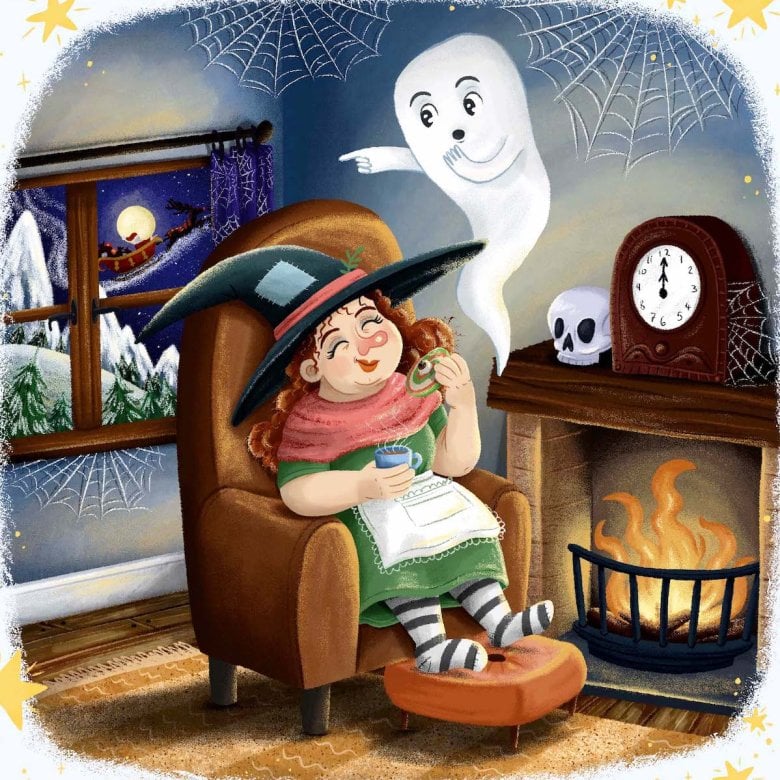How to become a children’s book illustrator

Image: 'The Christmas Witch' illustrated by Lucy Rogers, Salus Publishing
When we think of our favourite books from childhood, it’s not necessarily the narrative that springs to mind first – it's the captivating illustrations that brought the story to life. From the freewheeling style of Quentin Blake to the playful drawings of Judith Kerr, children’s book illustrators have the ability to transcend generations and root their work within our earliest memories.
Although the publishing industry is competitive, publishers are always on the lookout for new illustrators, so with a little determination, budding artists can make their ambitions of being a children’s book illustrator into a successful career.
In this article, we talked to Illustration lecturer Julie Ann Monks and Falmouth graduates-turned-book-illustrators, Rebecca Cobb (‘The Paper Dolls’), Ella Bailey (‘My Monster and Me’) and Lucy Rogers (‘The Night the Moon Went Out’) to hear their tops tips on how to become a children’s book illustrator.
What does a children’s book illustrator do?
A children’s book illustrator will design the artworks that help bring an author’s story to life. Most children’s book illustrators work as freelancers and have contracts with publishing houses. It’s usually an editor or art director of the publishing house who decides which illustrator would work well with a certain text.
If you’re paired with an author, you don’t necessarily have much contact with them as communication is done through the editor and the art director of the publishing house. However, if an author and an illustrator work particularly well together, this can turn into a long-term collaboration where the illustrator exclusively works on the author’s projects.
How to become a children’s book illustrator
There’s a wealth of children’s book publishers who are always looking for new illustrators to work with. If you’re an aspiring storybook illustrator, follow these tips to start building your career.
1. Develop your unique style
There’s no denying that the children’s publishing industry is competitive so it’s important to stand out from the crowd. The work of famous book illustrators, such as Quentin Blake and Shirley Hughes, is instantly recognisable and has a timeless appeal. Dedicating time to developing your own unique style will set you apart from the competition.
Ella Bailey has written and illustrated her own children’s books since graduating from Falmouth in 2013. Ella says: “I have been learning new things and developing my work constantly in the years since I graduated, to the point that I think this might be my top tip for aspiring children’s book illustrators: always be open to learning and trying new things!”
2. Practise your drawing skills
Publishers look for certain skills in an illustrator, most importantly the ability to tell a story through imagery and bring the written word to life. They also want to see more technical skills, like the ability to draw people – particularly children – as they tend to feature heavily in stories for young people.
Publishers may want to see how you work with colour as children’s book illustrations are often vibrant and eye-catching. Good drawing skills form the foundations of any successful children’s book illustration so keep practising and experimenting.
3. Understand your market
Spend time looking at publishers’ websites or visit your local bookshop to see what children’s book titles are currently selling. Children’s fiction is marketed at different age groups so look at how the style of illustrations vary depending on the target age bracket. For example, illustrations for younger age groups tend to be simple, colourful and friendly. Whereas book illustrations for older children become more sophisticated and use different colour pallets.
Falmouth alumna, Rebecca Cobb has illustrated children’s books for authors including Richard Curtis and Julia Donaldson. Rebecca says: “My advice for anyone wanting to be a children’s book illustrator would be to read lots of children’s books and to do lots of drawing. Draw what you love and really enjoy. I think my work always looks better when I have either had fun with a project or enjoyed the challenge of it.”
4. Get your artwork seen
As well as having a physical portfolio, it’s good to have a digital space to promote your work. There are many benefits to having your own website, such as a space to curate your own gallery of work and showcase your brand. Instagram is also a helpful platform to show preparatory drawings and moving image work of your creative process, which is something publishers like to see.
Publishers actively look for new material so take advantage of any opportunities to exhibit your work, such as at group exhibitions. Many publishers run competitions, including the Searchlight Awards, BolognaRagazzi Award and The Unpublished Picturebook Showcase. Entering competitions brings your work to the attention of publishers and has the potential to raise your profile when you’re early in your career.
Don’t be afraid to contact a publisher directly. Send them a postcard of your work or an email with a link to your website and explain why you’d love to work with them and why you think you’d be a good ‘fit’ on their books.
5. Ask if an agent is right for you
As a children’s book illustrator, there are obvious advantages of having an agent, including the connections with publishers. However, it’s also good to have experience of meeting publishers and art directors yourself.
Ella recently signed with Tugeau 2 but worked independently for several years. Ella says: “Graduates should consider whether they’d like to represent themselves or look for an agent. I spent my first few years working independently – it was only quite recently, in 2021, that I decided to join an agency. I think both ways of operating have their advantages, but I’ve found that I enjoy having the extra point of contact and the sense of community that being in an agency provides. Plus, it’s nice not to have to handle quite so much admin!”
6. Keep being persistent
Even the most successful children’s book illustrators have encountered some rejection in their careers so it’s important to not give up and keep challenging yourself. Focus on making good quality work, keep generating new ideas and try to get it in front of as many people as you can.
Lucy Rogers has illustrated books for Bloomsbury, Harper Collins and the National Deaf Children’s Society. When asked what her top tip for aspiring children’s book illustrators would be, she said: “Stay confident and don’t give up. The industry involves a lot of hard work; you will face rejection and criticism, but you have to remain strong and keep on practicing your skill. Keep drawing every day to get better.”
Rebecca adds: “Don’t give up – it took me a long time to get any work as a picture book illustrator and I almost gave up at one point, but I am so glad that I didn’t!”
7. Consider studying a degree
Although it’s not the only way to break into the industry, a degree in an art or design subject will give you the academic training to refine your drawing skills and the space to experiment with different art mediums and styles.
From the very first year of our Illustration BA(Hons) course, students can choose to explore narrative illustration and produce their own illustrated book. Through project briefs, workshops, and collaborative projects, students can connect with publishers, art directors and illustration agencies. Our guest speaker programme also allows students to hear from leading illustrators, such as Dave McKean and Laura Carlin.
Reflecting on her time at Falmouth, Ella said: “During my degree, I was taught how to construct a picture book, the importance of pacing and flow, how to develop strong characters, and even how to write a text. I was lucky enough to have a story I was working on at university picked up by a publisher. I think that first book really allowed me to get my foot in the door.”
In the third year of Falmouth’s Illustration degree, students go on a study trip to Bologna Children’s Book Fair which is an international event where publishers from all over the world go to sell their books to other publishers. With a whole host of exhibitions, talks and stands, it’s a great opportunity to network with publishers and illustrators.
Lucy says: “The Illustration course prepared me for a lot of the business side in the industry. I learnt how to prepare my portfolio, look for new work and quote and invoice clients. It was also the time at university that allowed me to experiment and find my style.”
Becoming a children’s book illustrator takes hard work and determination but it can be a highly rewarding career.
Want to use your creativity to help children unlock imaginary worlds?
Lead image: 'The Christmas Witch' illustrated by Lucy Rogers, Salus Publishing




